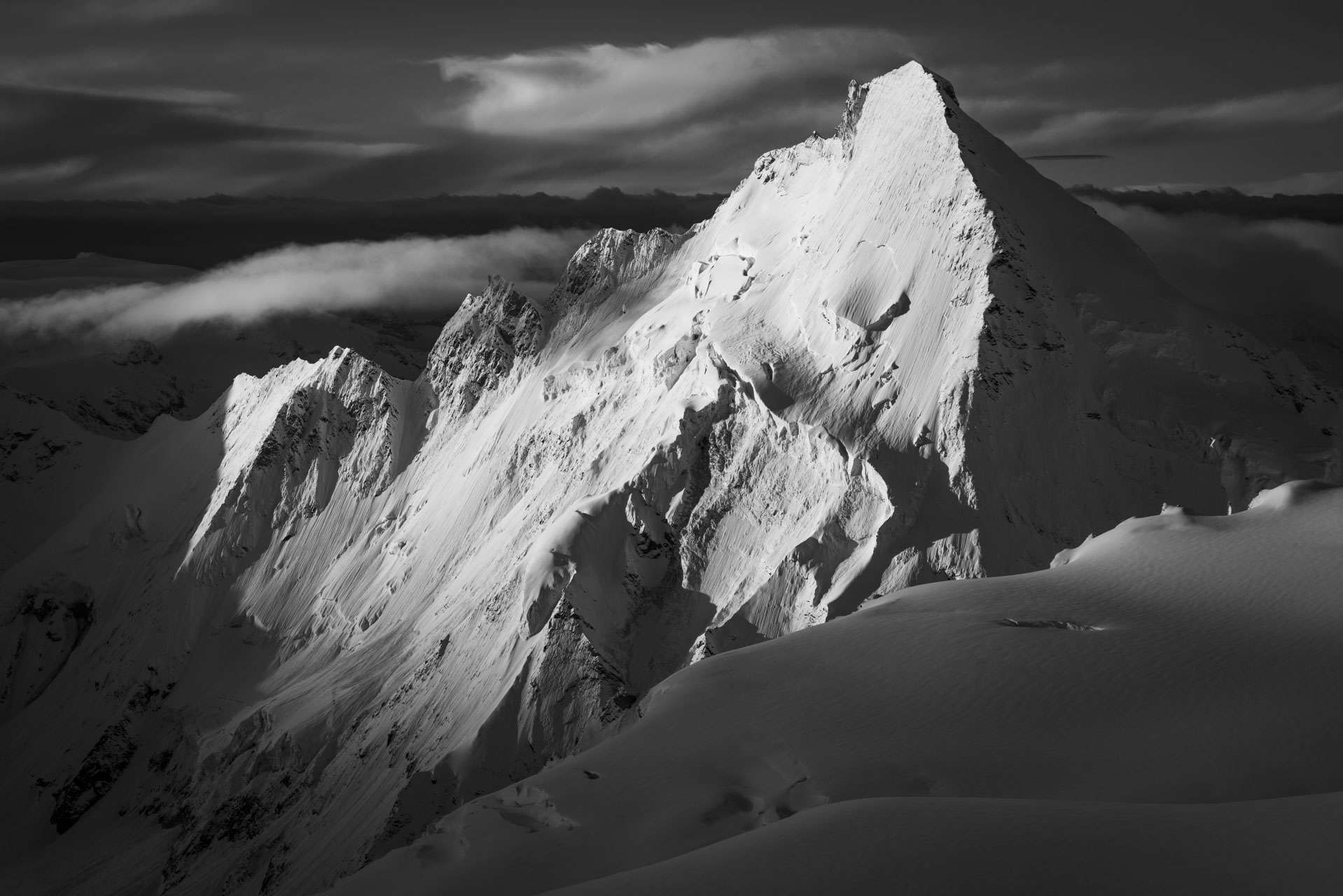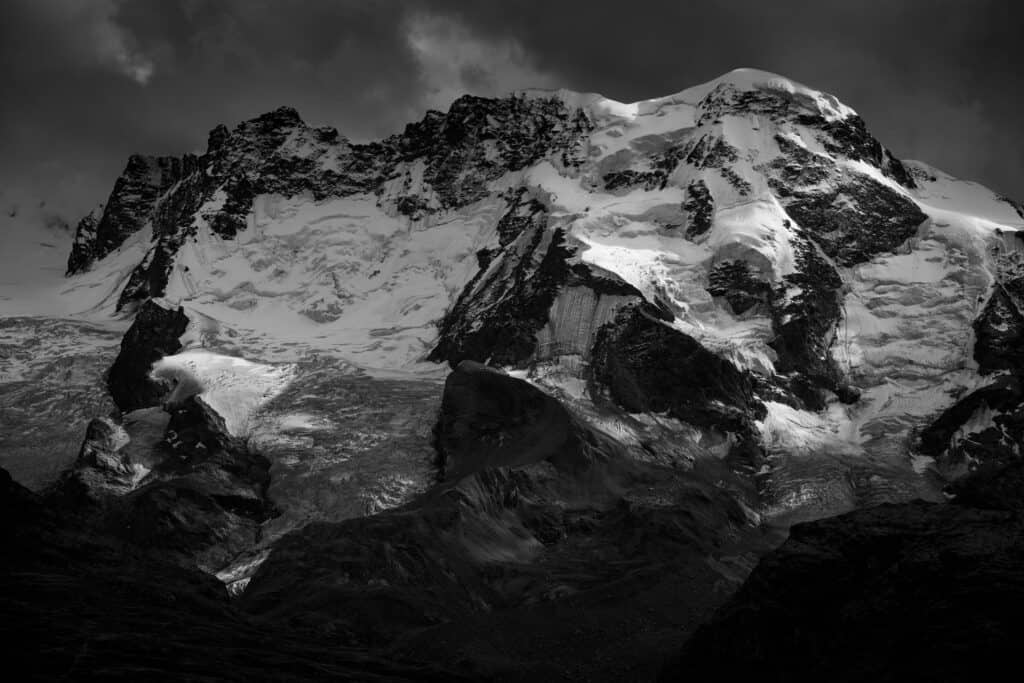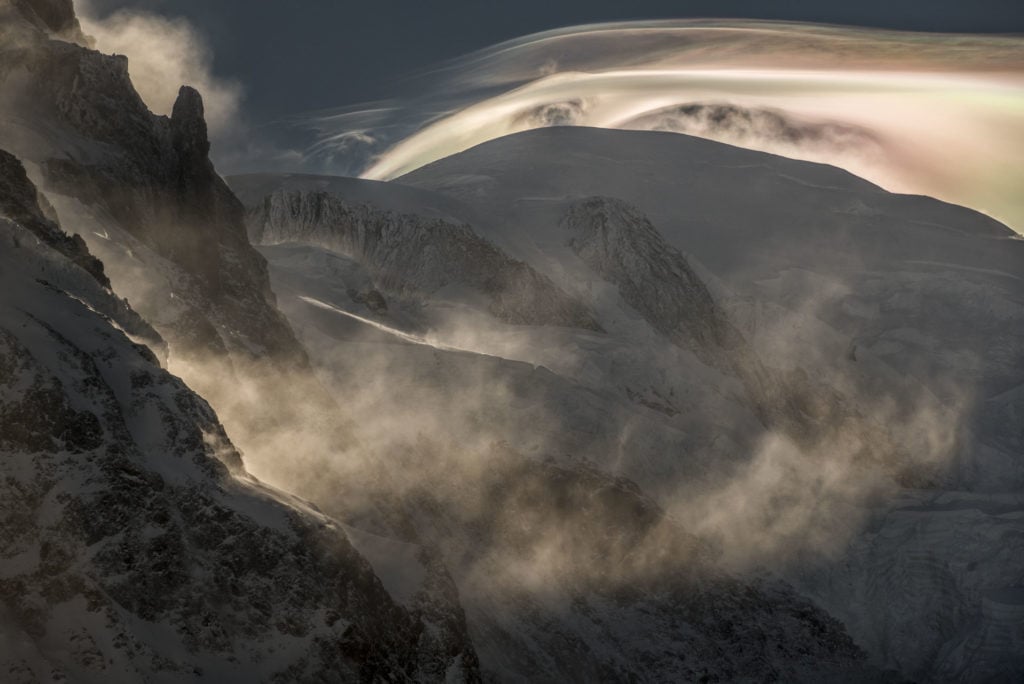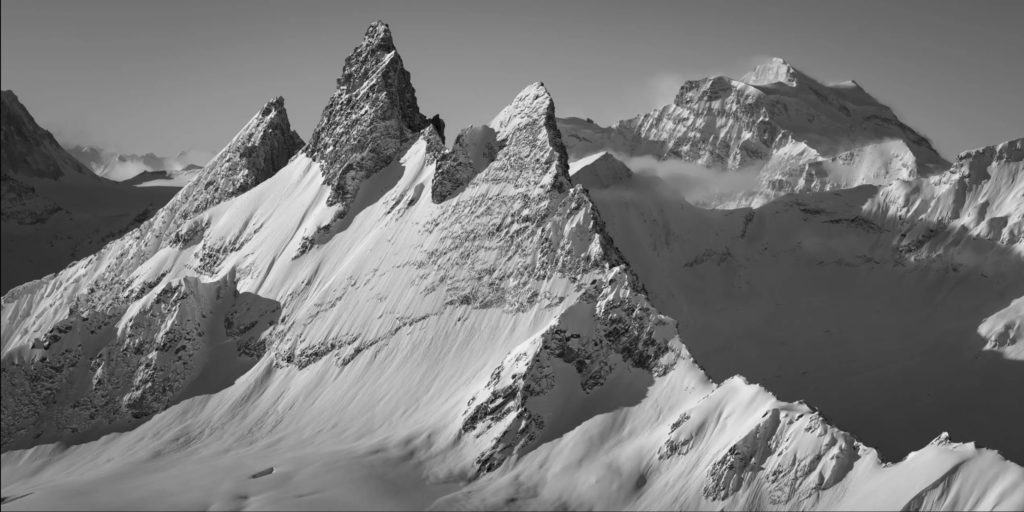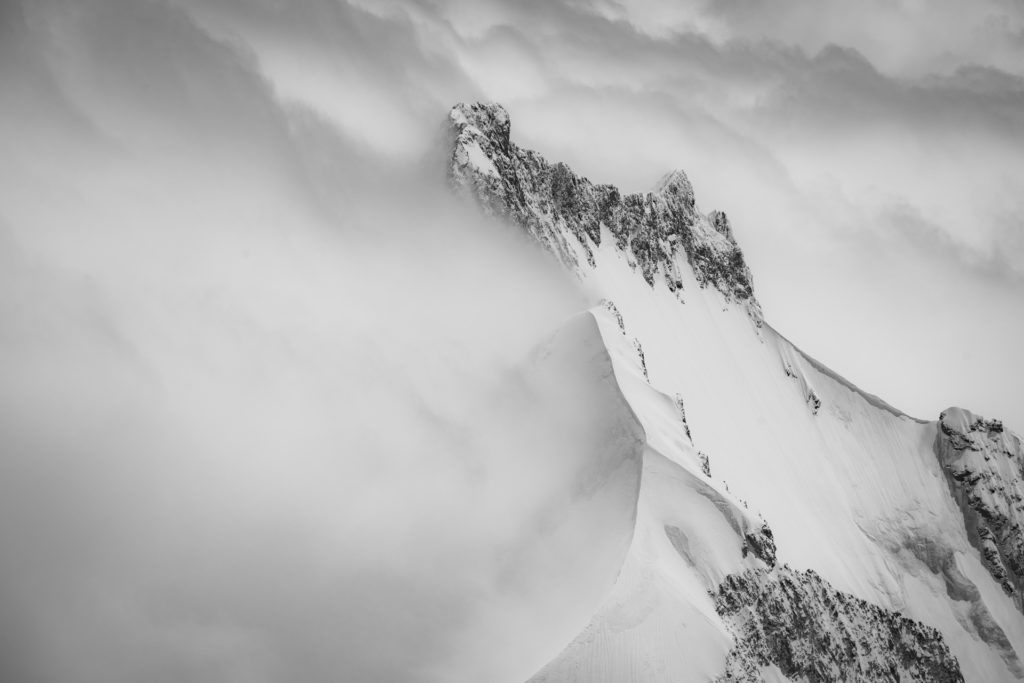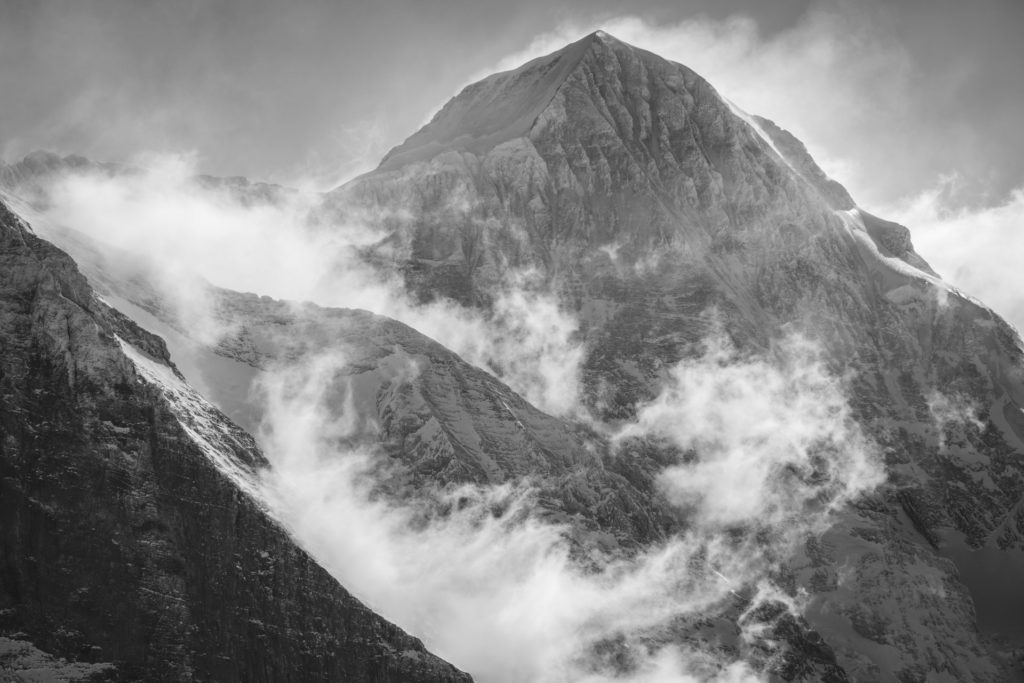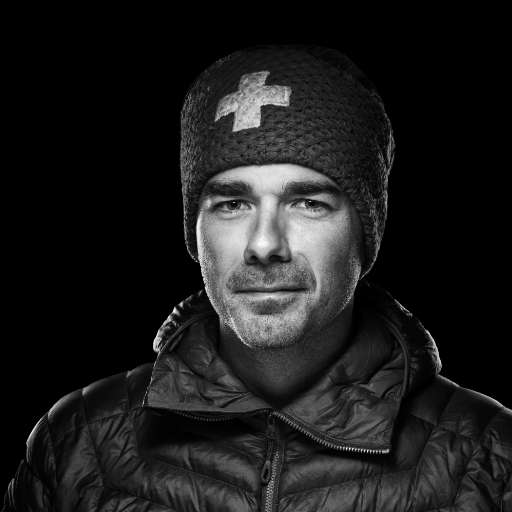Can you hear the echo of an impenetrable mountain? On the borders of Switzerland and Italy, it hides in the shadows of its dazzling sisters. Hiding its infinite beauty from the eyes of the world. Today, I'd like to tell you the story of the Dent d'Hérensthe elusive treasure of the Valais Alps.
The Dent d'Hérens : Birth of an Alpine giant on the Swiss-Italian border
The Dent d'Hérens arose several million years ago from the brutal clash of the tectonic plates of Africa and Europe. From the folding of the rocks, the mountain awoke and pointed skywards in a sudden burst of beauty. Overlooking the Valais Alps, summit rises to an altitude of 4,173 metres on the border between Switzerland and Italy. Its ridges stretch from the Tiefmattenjoch to the Col de Tournanche. And if you follow its eastern ridge, you'll find that it forms one of the longest ridges in the Alps, along with the Lion ridge leading to the Matterhorn. Four kilometers of a journey between earth and sky, linking two giants at the crossroads of worlds.
Like the Matterhorn, its legendary brother, the Dent d'Hérens is made up of the metamorphic rocks of the Dent Blanche nappe. A blend of orthogneiss, granite and oiled gneiss, the mountain sparkles and proudly displays its thousand-year-old history. But it also conceals other fascinating secrets. When viewed from the heights of Switzerland, the Dent d'Hérens seems to shine in a completely different light. Imposing hanging glaciers adorn its north face in a unique way. And beneath this gleaming armour lies a veritable treasure trove. A tongue of the Valpelline unit covers the steep flanks of its north face. A monochrome of gneiss, gabbro and granite, combined with the whiteness of the marble, the better to praise the "Valpelline". The Dent d'Hérens a wild, undiscovered summit.
The Dent d'Hérens The elusive treasure of the Valais Alps
For the mountain is discreet. Like an elusive muse, they escape the gaze of men as much as they captivate their imagination. A master in the art of remaining invisible, she remains in the shadow of the titans she rubs shoulders with. From val d’Anniviers to the Zermatt valley, it is thus masked by the colossal peaks of the Imperial Crown of Zinal. From Gornergrat, the Dent d'Hérens is hidden behind the Matterhorn. And from the famous Gemmi Pass, it hides behind Dent Blanche. If you want to unravel the mystery of this grandiose summit , then you'll have to go and meet her. From Zermatt to the Schönbiel hut, a magnificent path leads along the valley and the Zmutt glacier to the foot of the Matterhorn. And from there, you'll have a breathtaking view of one of the most beautiful summits 4000-meter peaks in the Valais Alps. The Dent d'Hérens Matterhorn is a majestic mountain of remarkable stature.
First ascent of the Dent d'Hérens Melchior Anderegg's feat of climbing
Climbing the Dent d'Hérens is an adventure. Whatever route you take, it's a long way to summit. An isolated mountain on the edge of the Valais, it demands the utmost tenacity. Of all the mountaineers who have conquered the Alps, it was Melchior Anderegg who achieved the feat. On August 12, 1863, he accompanied William Edward Hall, Florence Crauford Grove, Reginald John Somerled MacDonald and Montagu Woodmass, assisted by Peter Perren and Jean-Pierre Cachat, to summit of the Dent d'Hérens.

This first ascent opens up the Italian side of the normal route. Departing from the Grandes Murailles glacier, the climbers set off along the south-west face of the Dent d'Hérens. A perilous climb in an exceptional landscape. The men haul themselves up icy slopes and steep rocks. They face slabs so imposing that J.S. MacDonald speculates that they may have come from the Matterhorn itself! Under a blazing sun, the team continues to advance. They stay focused, never giving in.
Then comes the last step that leads them to summit . The Dent d'Hérens. Drunk with happiness, they savor the moment. Exhausted, but happy to have achieved this historic feat together. A few days earlier, Edward Whymper had also attempted to conquer the mountain. With Jean Antoine Carrel and Luc Meynet, they tried their luck on the west ridge of the Dent d'Hérens. But faced with the instability of the rock, the mountaineer had to give up, experiencing this defeat as a terrible failure.
The north face of the Dent d'Hérens North face: climbing an impassable wall of ice
The climbs then follow at summit . Dent d'Hérens. On January 16, 1910, M. Piacenza, J.-J. Carrel and B. Pellissier completed the mountain's first winter ascent. Little by little, its unexplored routes were conquered by man. Its ridges opened up to the world, then came the turn of its faces. And it was in 1925 that a roped party managed to climb the north face of the mountain for the first time. Dent d'Hérens. 1300 metres of ascent in the heart of an unforgiving and superb glacial landscape. On August 10, Willi Welzenbach and Eugen Allwein set off up the vertiginous, serac-laden face of the Tiefmattengletscher. With great effort and courage, they overcame the ordeal and successfully reached the summit of the Tiefmattengletscher. Dent d'Hérens.
Thanks to their daring, they opened up a direct route along the mountain's north face that day. A race to the limits of the extreme, which whetted the appetite of the greatest glaciers. But over and above their bravery, the team also owed their victory to the lessons learned from the expedition led on August 2, 1923 by George Ingle Finch, accompanied by G. Forster and R. Peto. Along this impregnable north face, he traced a route to the large terraces and hanging glaciers that protect summit from any incursion. It's impossible for him to breach this defensive rampart. He then has no choice but to divert his trajectory and attempt to reach the eastern ridge of the Dent d'Hérens. After reaching a terrace later named Finch in his honor, he had to face a gaping rimaye to reach the famous ridge. Once over this ice obstacle, he led the team to summit via the mountain's east ridge. Success is the order of the day, but the ordeal is formidable.

Ascent of the north face of the Dent d'Hérens wild and relentless mountain
The Dent d'Hérens the hidden treasure of the Valais Alps, becomes the scene of the most intense joys as well as the worst dramas. In March 1963, Italian mountaineers R. Merendi, R. Daguin and G. Bosco disappeared, probably swept away by an avalanche, while attempting to tackle the north face in winter. In 1964, a Polish, German and Swiss expedition honored their memory by making the first winter ascent of this north face, so resistant to human assault.
On March 14, Jerzy Hajdukiewicz and Krzysztof Berbeka embark on their adventure alongside Gerhard Deves, Leo Herncarek, Eckhart Grassmann, Pierre Monkewitz and Dieter Naef. The challenge was immense, but they persevered, reaching summit on March 17. Unfortunately, the high mountains sometimes have a cruel fate in store for the climbers who set foot on them. On March 18, Krzysztof Berbeka lost his balance on the way down, taking Jerzy Hajdukiewicz with him. A 200-metre plunge into the void that could have proved fatal for the whole team had Dieter Naef not been able to hold them back.
With the two Poles suffering broken bones, the team decided to split up. And while Gerhard Deves and Dieter Naef looked after their wounded, the others continued their descent in search of help. Four days of interminable waiting. Four long days in which the climbers saw their lives pass them by before finally being taken care of by the hospital services. But the efforts of their companions and rescuers were not enough. Krzysztof Berbeka died of his injuries shortly afterwards. Leo Herncarek and Dieter Naef had their toes and feet amputated. The high mountains are as beautiful as they are dangerous.
Isolated and wild Dent d'Hérens remains an unspoilt jewel in the Valais Alps. Far from the hustle and bustle of the Haute Route Chamonix- Zermatt. Far, too, from the most popular and illustrious peaks. It offers those who pay attention an unforgettable experience. An exhilarating, rugged journey through sumptuous landscapes, like an initiation quest to the high mountains.
